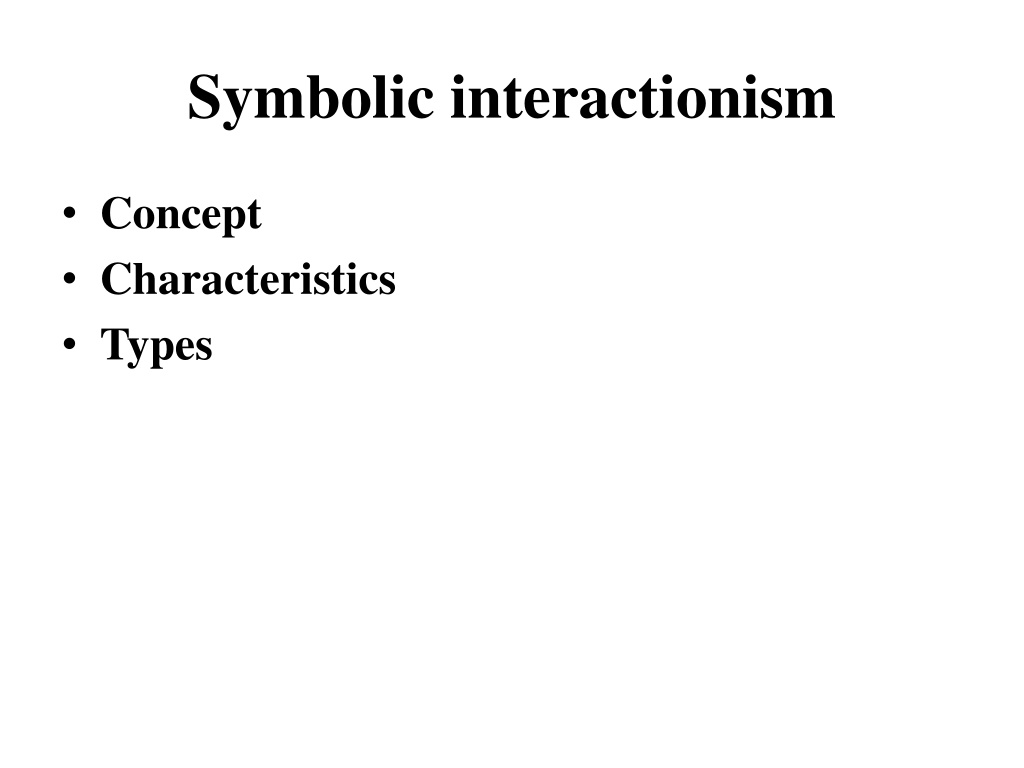Understanding Symbolic Interactionism in Sociology
Symbolic Interactionism is a school of thought in sociology that focuses on how individuals interact with each other through symbols, shaping social structures. It highlights the role of symbols in defining actions and meanings in social interactions. The concept explores how different socializing experiences impact an individual's life cycle and how individuals construct their realities through symbols. Symbolic Interactionism is rooted in social psychology and is crucial for teachers in multicultural settings to recognize cultural differences in students' perceptions and motivations. Research using this perspective can delve into how children from diverse backgrounds perceive school environments. Data analysis methods vary based on research strategies and data collection techniques, such as organizing interview data by individual respondents or grouping responses.
Download Presentation

Please find below an Image/Link to download the presentation.
The content on the website is provided AS IS for your information and personal use only. It may not be sold, licensed, or shared on other websites without obtaining consent from the author. Download presentation by click this link. If you encounter any issues during the download, it is possible that the publisher has removed the file from their server.
E N D
Presentation Transcript
Symbolic interactionism Concept Characteristics Types
Symbolic interactionism is a school of thought in sociology that explains social behavior in terms of how people interact with each other via symbols; in this view, social structures are best understood in terms of such individual interactions. ... Mead believed that one's self develops through social interactions.
Symbolic interactionism provides opportunities for analyzing ways in which different socializing experiences affect an individual's life cycle, the argument being that individuals do not react automatically to special stimuli, but through their own constructive processes use symbols to define their actions and meanings .
Disciplinary roots social psychology Central questions- what conman set of symbols and understandings have emerged to give meanings to peoples interactions?
Symbolic interactionalism stems from social psychology and has been used to great extent in linguistics as well. A premise of symbolic interactionism is the belief that people act according to how they understand the meaning of words ,things and acts in their environment.
Importance It is important for teachers in our multicultural society to understand that the students coming from different cultural backgrounds will understand the world differently. Test performance, motivation to do well in school and like will differ depending upon the students cultural history.
Research using a symbolic interactionism perspective might investigate how different children from different backgrounds perceive and comprehend the school environment.
Data analysis Organizing the data The method of organizing data will differ upon the research strategy and data collection techniques used. Interview data may be organized according to individual respondents or if a standard format is used with a number of individuals by grouping answers together across respondents
Similarly observations may be considered individually or grouping similar types of occurances together while looking for differences among individuals settings or times .
Second stage Data analysis ,description The researcher describes the various pertinent aspects of the study including the settings both temporal and physically the individual being studied The purpose of any activities examined ,the viewpoint of participants and the effects of any activities on the participants.
Third stage Analysis ,interpretation Involves explaining the findings answering why questions attaching significance to particular results and putting patterns into an analytic framework. Interpretation of qualitative research data is more dependent on researcher background skills, biases and knowledge than conclusion drawn from quantitative research.
Challenges in qualitative data analysis To make sense of massive amount of data. Reduce the volume of information. Identify significant pattern. Construct a framework for communicating the essence of what the data reveal.
Symbolic interactionism The view of social behaviour that emphasizes linguistic or gestural communication and its subjective understanding, especially the role of language in the formation of the child as a social being.
Symbolic interactionism is a theoretical approach to understanding the relationship between humans and society. The basic notion of symbolic interactionism is that human action and interaction are understandable only through the exchange of meaningful communication or symbols. In this approach, humans are portrayed as acting, as opposed to being acted upon. The main principles of symbolic interactionism are: Human beings act toward things on the basis of the meanings that things have for them These meanings arise out of social interaction Social action results from a fitting together of individual lines of action
This approach stands in contrast to the strict behaviorism of psychological theories prevalent at the time it was first formulated (the 1920s and 1930s). According to symbolic interactionism, humans are distinct from infra humans (lower animals) because infra humans simply respond to their environment (i.e., a stimulus evokes a response or stimulus response), whereas humans have the ability to interrupt that process (i.e., stimulus cognition response). Additionally, infra humans are unable to conceive of alternative responses to gestures. Humans, however, can. This understanding should not be taken to indicate that humans never behave in a strict stimulus response fashion, but rather that humans have the capability of responding in a different way, and do so much of the time.
According to symbolic interactionism, the objective world has no reality for humans; only subjectively defined objects have meaning. There is no single objective reality ; there are only (possibly multiple, possibly conflicting) interpretations of a situation. Meanings are not entities that are bestowed on humans and learned by habituation; instead, meanings can be altered through the creative capabilities of humans, and individuals may influence the many meanings that form their society. Human society, therefore, is a social product.
categories situated, personal and social. (Situated identity refers to the ability to view themselves as others do).
THANKS Dr Kalpana Patni Lakhera Assistant Professor,Education Uttarakhand Open University, Haldwani.























